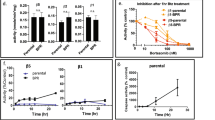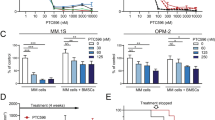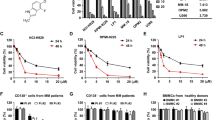Abstract
Proteasome inhibition is a novel treatment for several hematological malignancies. However, resistance to the proteasome inhibitor bortezomib (BTZ, Velcade) is an emerging clinical impediment. Mutations in the β5 subunit of the proteasome, the primary target of BTZ, have been associated with drug resistance. However, the exact mechanism by which these mutations contribute to BTZ resistance, is still largely unknown. Toward this end, we here developed BTZ-resistant multiple myeloma (8226) and acute lymphoblastic leukemia (CCRF-CEM) cell line models by exposure to stepwise increasing concentrations of BTZ. Characterization of the various BTZ-resistant cells revealed upregulation of mutant β5 subunit of the proteasome. These newly identified β5-subunit mutations, along with previously described mutations, formed a mutation cluster region in the BTZ-binding pocket of the β5 subunit, that of the S1 specificity pocket in particular. Moreover, we provide the first evidence that the mechanism underlying BTZ resistance in these tumor cells is impaired binding of BTZ to the mutant β5 subunit of the proteasome. We propose that proteasome subunit overexpression is an essential compensatory mechanism for the impaired catalytic activity of these mutant proteasomes. Our findings further suggest that second-generation proteasome inhibitors that target the α7 subunit of the proteasome can overcome this drug resistance modality.
This is a preview of subscription content, access via your institution
Access options
Subscribe to this journal
Receive 12 print issues and online access
$259.00 per year
only $21.58 per issue
Buy this article
- Purchase on Springer Link
- Instant access to full article PDF
Prices may be subject to local taxes which are calculated during checkout






Similar content being viewed by others
References
Navon A, Ciechanover A . The 26 S proteasome: from basic mechanisms to drug targeting. J Biol Chem 2009; 284: 33713–33718.
Ortiz-Navarrete V, Seelig A, Gernold M, Frentzel S, Kloetzel PM, Hammerling GJ . Subunit of the ‘20S’ proteasome (multicatalytic proteinase) encoded by the major histocompatibility complex. Nature 1991; 353: 662–664.
Rivett AJ, Bose S, Brooks P, Broadfoot KI . Regulation of proteasome complexes by gamma-interferon and phosphorylation. Biochimie 2001; 83: 363–366.
Seifert U, Bialy LP, Ebstein F, Bech-Otschir D, Voigt A, Schroter F et al. Immunoproteasomes preserve protein homeostasis upon interferon-induced oxidative stress. Cell 2010; 142: 613–624.
Crawford LJ, Walker B, Ovaa H, Chauhan D, Anderson KC, Morris TC et al. Comparative selectivity and specificity of the proteasome inhibitors BzLLLCOCHO, PS-341, and MG-132. Cancer Res 2006; 66: 6379–6386.
Ruschak AM, Slassi M, Kay LE, Schimmer AD . Novel proteasome inhibitors to overcome bortezomib resistance. J Natl Cancer Inst 2011; 103: 1007–1017.
Mitsiades N, Mitsiades CS, Richardson PG, Poulaki V, Tai YT, Chauhan D et al. The proteasome inhibitor PS-341 potentiates sensitivity of multiple myeloma cells to conventional chemotherapeutic agents: therapeutic applications. Blood 2003; 101: 2377–2380.
Hideshima T, Mitsiades C, Akiyama M, Hayashi T, Chauhan D, Richardson P et al. Molecular mechanisms mediating antimyeloma activity of proteasome inhibitor PS-341. Blood 2003; 101: 1530–1534.
Obeng EA, Carlson LM, Gutman DM, Harrington Jr WJ, Lee KP, Boise LH . Proteasome inhibitors induce a terminal unfolded protein response in multiple myeloma cells. Blood 2006; 107: 4907–4916.
Mitsiades N, Mitsiades CS, Poulaki V, Chauhan D, Fanourakis G, Gu X et al. Molecular sequelae of proteasome inhibition in human multiple myeloma cells. Proc Natl Acad Sci USA 2002; 99: 14374–14379.
Hideshima T, Richardson P, Chauhan D, Palombella VJ, Elliott PJ, Adams J et al. The proteasome inhibitor PS-341 inhibits growth, induces apoptosis, and overcomes drug resistance in human multiple myeloma cells. Cancer Res 2001; 61: 3071–3076.
Vink J, Cloos J, Kaspers GJ . Proteasome inhibition as novel treatment strategy in leukaemia. Br J Haematol 2006; 134: 253–262.
Shah JJ, Orlowski RZ . Proteasome inhibitors in the treatment of multiple myeloma. Leukemia 2009; 23: 1964–1979.
Orlowski RZ, Kuhn DJ . Proteasome inhibitors in cancer therapy: lessons from the first decade. Clin Cancer Res 2008; 14: 1649–1657.
McConkey DJ, Zhu K . Mechanisms of proteasome inhibitor action and resistance in cancer. Drug Resist Updat 2008; 11: 164–179.
Messinger Y, Gaynon P, Raetz E, Hutchinson R, Dubois S, Glade-Bender J et al. Phase I study of bortezomib combined with chemotherapy in children with relapsed childhood acute lymphoblastic leukemia (ALL): a report from the therapeutic advances in childhood leukemia (TACL) consortium. Pediatr Blood Cancer 2010; 55: 254–259.
Kraus M, Ruckrich T, Reich M, Gogel J, Beck A, Kammer W et al. Activity patterns of proteasome subunits reflect bortezomib sensitivity of hematologic malignancies and are variable in primary human leukemia cells. Leukemia 2007; 21: 84–92.
Rückrich T, Kraus M, Gogel J, Beck A, Ovaa H, Verdoes M et al. Characterization of the ubiquitin-proteasome system in bortezomib-adapted cells. Leukemia 2009; 23: 1098–1105.
Lu S, Yang J, Song X, Gong S, Zhou H, Guo L et al. Point mutation of the proteasome beta5 subunit gene is an important mechanism of bortezomib resistance in bortezomib-selected variants of Jurkat T cell lymphoblastic lymphoma/leukemia line. J Pharmacol Exp Ther 2008; 326: 423–431.
Oerlemans R, Franke NE, Assaraf YG, Cloos J, van ZI, Berkers CR et al. Molecular basis of bortezomib resistance: proteasome subunit beta5 (PSMB5) gene mutation and overexpression of PSMB5 protein. Blood 2008; 112: 2489–2499.
Ri M, Iida S, Nakashima T, Miyazaki H, Mori F, Ito A et al. Bortezomib-resistant myeloma cell lines: a role for mutated PSMB5 in preventing the accumulation of unfolded proteins and fatal ER stress. Leukemia 2010; 24: 1506–1512.
Groll M, Berkers CR, Ploegh HL, Ovaa H . Crystal structure of the boronic acid-based proteasome inhibitor bortezomib in complex with the yeast 20S proteasome. Structure 2006; 14: 451–456.
Groll M, Kim KB, Huber R, Crews C . Crystal structure of epoxomicin:20s proteasome reveals a molecular basis for selectivity of alpha, beta-epoxyketone proteasome inhibitors. J Am Chem Soc 2000; 122: 1237–1238.
Unno M, Mizushima T, Morimoto Y, Tomisugi Y, Tanaka K, Yasuoka N et al. The structure of the mammalian 20S proteasome at 2.75 A resolution. Structure 2002; 10: 609–618.
Wang J, Cieplak P, Kollman PA . How well does a restrained electrostatic potential (RESP) model perform in calculating conformational energies of organic and biological molecules? J Comput Chem 2000; 21: 1049–1074.
Chauhan D, Singh AV, Aujay M, Kirk CJ, Bandi M, Ciccarelli B et al. A novel orally active proteasome inhibitor ONX 0912 triggers in vitro and in vivo cytotoxicity in multiple myeloma. Blood 2010; 116: 4906–4915.
Demo SD, Kirk CJ, Aujay MA, Buchholz TJ, Dajee M, Ho MN et al. Antitumor activity of PR-171, a novel irreversible inhibitor of the proteasome. Cancer Res 2007; 67: 6383–6391.
Muchamuel T, Basler M, Aujay MA, Suzuki E, Kalim KW, Lauer C et al. A selective inhibitor of the immunoproteasome subunit LMP7 blocks cytokine production and attenuates progression of experimental arthritis. Nat Med 2009; 15: 781–787.
Li X, Wood TE, Sprangers R, Jansen G, Franke NE, Mao X et al. Effect of noncompetitive proteasome inhibition on bortezomib resistance. J Natl Cancer Inst 2010; 102: 1069–1082.
Elsasser S, Schmidt M, Finley D . Characterization of the proteasome using native gel electrophoresis. Methods Enzymol 2005; 398: 353–363.
Parlati F, Lee SJ, Aujay M, Suzuki E, Levitsky K, Lorens JB et al. Carfilzomib can induce tumor cell death through selective inhibition of the chymotrypsin-like activity of the proteasome. Blood 2009; 114: 3439–3447.
Groll M, Ditzel L, Lowe J, Stock D, Bochtler M, Bartunik HD et al. Structure of 20S proteasome from yeast at 2.4 A resolution. Nature 1997; 386: 463–471.
Borissenko L, Groll M . 20S proteasome and its inhibitors: crystallographic knowledge for drug development. Chem Rev 2007; 107: 687–717.
Lu S, Yang J, Chen Z, Gong S, Zhou H, Xu X et al. Different mutants of PSMB5 confer varying bortezomib resistance in T lymphoblastic lymphoma/leukemia cells derived from the Jurkat cell line. Exp Hematol 2009; 37: 831–837.
Heinemeyer W, Gruhler A, Mohrle V, Mahe Y, Wolf DH . PRE2, highly homologous to the human major histocompatibility complex-linked RING10 gene, codes for a yeast proteasome subunit necessary for chrymotryptic activity and degradation of ubiquitinated proteins. J Biol Chem 1993; 268: 5115–5120.
Princiotta MF, Schubert U, Chen W, Bennink JR, Myung J, Crews CM et al. Cells adapted to the proteasome inhibitor 4-hydroxy- 5-iodo-3-nitrophenylacetyl-Leu-Leu-leucinal-vinyl sulfone require enzymatically active proteasomes for continued survival. Proc Natl Acad Sci USA 2001; 98: 513–518.
La RP, Deininger MW . Resistance to imatinib: mutations and beyond. Semin Hematol 2010; 47: 335–343.
Engelman JA, Janne PA . Mechanisms of acquired resistance to epidermal growth factor receptor tyrosine kinase inhibitors in non-small cell lung cancer. Clin Cancer Res 2008; 14: 2895–2899.
Vassetzky YS, Alghisi GC, Gasser SM . DNA topoisomerase II mutations and resistance to anti-tumor drugs. Bioessays 1995; 17: 767–774.
Lu S, Chen Z, Yang J, Chen L, Gong S, Zhou H et al. Overexpression of the PSMB5 gene contributes to bortezomib resistance in T-lymphoblastic lymphoma/leukemia cells derived from Jurkat line. Exp Hematol 2008; 36: 1278–1284.
Ashworth A . Drug resistance caused by reversion mutation. Cancer Res 2008; 68: 10021–10023.
Paquet AC, Baxter J, Weidler J, Lie Y, Lawrence J, Kim R et al. Differences in reversion of resistance mutations to wild-type under structured treatment interruption and related increase in replication capacity. PLoS One 2011; 6: e14638.
Richardson PG, Sonneveld P, Schuster MW, Irwin D, Stadtmauer EA, Facon T et al. Bortezomib or high-dose dexamethasone for relapsed multiple myeloma. N Engl J Med 2005; 352: 2487–2498.
Mateos MV, Richardson PG, Schlag R, Khuageva NK, Dimopoulos MA, Shpilberg O et al. Bortezomib plus melphalan and prednisone compared with melphalan and prednisone in previously untreated multiple myeloma: updated follow-up and impact of subsequent therapy in the phase III VISTA trial. J Clin Oncol 2010; 28: 2259–2266.
Hrusovsky I, Emmerich B, von RA, Voegeli J, Taverna C, Olie RA et al. Bortezomib retreatment in relapsed multiple myeloma - results from a retrospective multicentre survey in Germany and Switzerland. Oncology 2010; 79: 247–254.
Wang L, Kumar S, Fridley BL, Kalari KR, Moon I, Pelleymounter LL et al. Proteasome beta subunit pharmacogenomics: gene resequencing and functional genomics. Clin Cancer Res 2008; 14: 3503–3513.
Shaughnessy Jr JD, Qu P, Usmani S, Heuck CJ, Zhang Q, Zhou Y et al. Pharmacogenomics of bortezomib test-dosing identifies hyperexpression of proteasome genes, especially PSMD4, as novel high-risk feature in myeloma treated with total therapy 3. Blood 2011; e-pub ahead of print 31 May 2011.
Acknowledgements
This study was supported by grants from the Stichting Translational Research, Cancer Center Amsterdam (to JC), NWO-AGIKO (to NEF). YGA is recipient of visiting professor fellowships from the Royal Netherlands Academy of Arts and Sciences (KNAW) and the Netherlands Organization for Scientific Research (NWO) and his scientific contributions are also supported by the Dutch Foundation Children Cancer-free (KIKA).
Author information
Authors and Affiliations
Corresponding author
Ethics declarations
Competing interests
The authors declare no conflict of interest.
Additional information
Supplementary Information accompanies the paper on the Leukemia website
Supplementary information
Rights and permissions
About this article
Cite this article
Franke, N., Niewerth, D., Assaraf, Y. et al. Impaired bortezomib binding to mutant β5 subunit of the proteasome is the underlying basis for bortezomib resistance in leukemia cells. Leukemia 26, 757–768 (2012). https://doi.org/10.1038/leu.2011.256
Received:
Revised:
Accepted:
Published:
Issue Date:
DOI: https://doi.org/10.1038/leu.2011.256
Keywords
This article is cited by
-
Interplay between proteasome inhibitors and NF-κB pathway in leukemia and lymphoma: a comprehensive review on challenges ahead of proteasome inhibitors
Cell Communication and Signaling (2024)
-
A novel 2-iminobenzimidazole compound, XYA1353, displays in vitro and in vivo anti-myeloma activity via targeting NF-κB signaling
Molecular and Cellular Biochemistry (2023)
-
Lactate Decreases Bortezomib Sensitivity and Predicts Poor Clinical Outcomes of Multiple Myeloma
Current Medical Science (2023)
-
A clinically relevant pulse treatment generates a bortezomib-resistant myeloma cell line that lacks proteasome mutations and is sensitive to Bcl-2 inhibitor venetoclax
Scientific Reports (2022)
-
Targeting ubiquitin-specific protease-7 in plasmacytoid dendritic cells triggers anti-myeloma immunity
Leukemia (2021)



